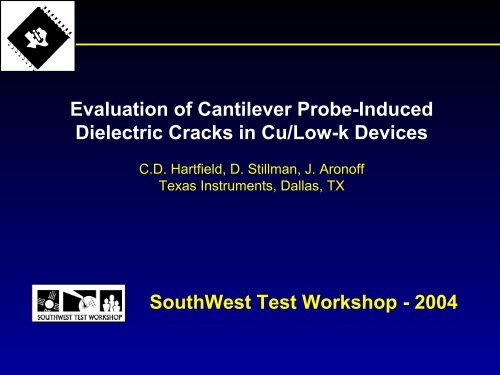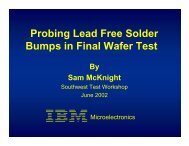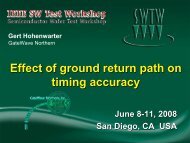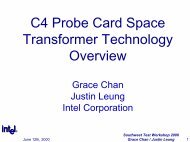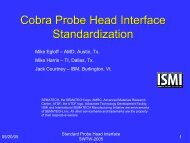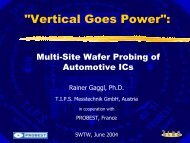Evaluation of Cantilever Probe-Induced Dielectric Cracks
Evaluation of Cantilever Probe-Induced Dielectric Cracks
Evaluation of Cantilever Probe-Induced Dielectric Cracks
You also want an ePaper? Increase the reach of your titles
YUMPU automatically turns print PDFs into web optimized ePapers that Google loves.
<strong>Evaluation</strong> <strong>of</strong> <strong>Cantilever</strong> <strong>Probe</strong>-<strong>Induced</strong><br />
<strong>Dielectric</strong> <strong>Cracks</strong> in Cu/Low-k Devices<br />
C.D. Hartfield, D. Stillman, J. Aron<strong>of</strong>f<br />
Texas Instruments, Dallas, TX<br />
SouthWest Test Workshop - 2004
Outline<br />
• Objectives<br />
• Background<br />
• Approach<br />
• Test Results<br />
• Implications<br />
<br />
<br />
Card maintenance<br />
Assembly and Reliability<br />
• Summary<br />
Hartfield et al.<br />
SWTW - 2004<br />
June 7, 2004<br />
Page 2
Objectives<br />
• Delineate multiprobe-induced crack risk to<br />
materials beneath the bond pads <strong>of</strong> Cu/Low-k<br />
devices<br />
<br />
<br />
<strong>Cantilever</strong> cards<br />
Wirebond Devices<br />
• Show effects <strong>of</strong> varying individual parameters <strong>of</strong><br />
needle geometries / properties<br />
• Make case for industry-wide attention to develop<br />
card build specifications and/or practices that will<br />
eliminate the crack risk<br />
Hartfield et al.<br />
SWTW - 2004<br />
June 7, 2004<br />
Page 3
Background<br />
• Damage to Cu/Low-k devices during fabrication, probe,<br />
and assembly is a long-term reliability concern<br />
<br />
<br />
Low-k materials tend to have lower modulus and hardness<br />
Fracture toughness reduced; difficult to measure<br />
• <strong>Probe</strong> – induced cracking <strong>of</strong> devices is an ongoing test<br />
industry issue<br />
<br />
<br />
Historical Information: Aluminum – SiO2 Technology<br />
TI: Metal structures changed and probing refined to eliminate probe cracks in<br />
lookahead builds, allowing successful qualification and ramp (unpublished<br />
information, ~1999).<br />
Chartered: <strong>Probe</strong>-induced IMD cracks cause infant mortality failures having high<br />
resistance (ISTFA 2003).<br />
Cu/Low-k Technology<br />
IBM: probe damage occurs with SiLK low-k dielectric (ISTFA 2001)<br />
“The intrinsic inability to control tip contact forces with conventional tungsten<br />
tip probing techniques results in damage to the Cu interconnects and<br />
deformation <strong>of</strong> the underlying low k dielectric film.”<br />
Hartfield et al.<br />
SWTW - 2004<br />
June 7, 2004<br />
Page 4
Background<br />
• Low-k <strong>Dielectric</strong> Material Properties<br />
Fracture Toughness K IC (MPa m 1/2 )<br />
1000<br />
100<br />
10<br />
1.0<br />
0.01<br />
Fracture<br />
Toughness-Modulus<br />
1000<br />
1<br />
100<br />
10<br />
0.1<br />
Guide Line<br />
K IC<br />
/ E = C<br />
0.01<br />
Polymer<br />
foams<br />
Nylons<br />
Engineering<br />
polymers Balsa<br />
PVC<br />
WoodEpoxies<br />
Polyester<br />
Porous<br />
ceramics<br />
Ice<br />
Low-k<br />
Films<br />
alloys<br />
Engineering<br />
composites<br />
K IC / E = C (kJ/m 2 )<br />
Engineering<br />
Ti<br />
alloys<br />
Steels<br />
Laminates<br />
Cast<br />
Irons<br />
Rocks<br />
Pottery<br />
Glass<br />
Silica<br />
Cement<br />
Concrete<br />
Plaster<br />
1000<br />
100<br />
0.01 0. 1 1 10 100 1000<br />
10<br />
1<br />
0.1<br />
Youngs Modulus, E (GPa)<br />
Conventional<br />
CVD <strong>Dielectric</strong>s<br />
Low-k<br />
dielectrics<br />
are in a class<br />
<strong>of</strong> their own<br />
concerning<br />
combined<br />
modulus and<br />
fracture<br />
toughness<br />
properties.<br />
Hartfield et al.<br />
SWTW - 2004<br />
June 7, 2004<br />
Page 5
Background (cont.)<br />
Cu<br />
Early insights: “Fracture Toughness” <strong>Probe</strong> Tests<br />
• No industry method available to measure low-k film fracture<br />
toughness<br />
• Use multiprobe as realistic “engineering test” to compare<br />
material performance<br />
Matrix <strong>of</strong> varied touchdowns and overtravel applied to blanket films.<br />
Allowed ranking <strong>of</strong> dielectric materials<br />
Allowed assessment <strong>of</strong> probe-induced crack risk<br />
(vary thickness)<br />
Low-k<br />
Aluminum<br />
Si<br />
Overtravel (µm)<br />
40 50 60 70<br />
Touchdowns (TD)<br />
1x 2x 4x 8x<br />
Record<br />
% cracks<br />
per cell<br />
(vary load)<br />
Material Rank<br />
1. OSG1<br />
2. HSQ<br />
3. OSG2<br />
4. polymer<br />
2500A Cu<br />
BCF3.0g/mil<br />
8x TD<br />
0% cracks<br />
Hartfield et al.<br />
SWTW - 2004<br />
June 7, 2004<br />
Page 6
Background (cont.)<br />
• Assessments <strong>of</strong> <strong>Probe</strong> Crack Risk on Full Flow<br />
Integrated Test Die<br />
<br />
<br />
Stress condition intrinsic function <strong>of</strong> integration strategy<br />
More representative <strong>of</strong> true crack risk from multiprobe<br />
Damage occurs at conditions that showed good results on blankets<br />
Low-k devices with greater metal levels have less crack risk<br />
DOE<br />
4 level metal<br />
High<br />
force (2x)<br />
Bond Pad<br />
FSG<br />
Low-k<br />
Production<br />
force<br />
3 level metal<br />
High<br />
force (2x)<br />
Bond Pad<br />
FSG<br />
Low-k<br />
Production<br />
force<br />
Touchdowns<br />
% cracks<br />
8x<br />
Background (cont.)<br />
• Experiments prove factors other than load are critical<br />
for cracks<br />
Micromanipulator Tests<br />
• Two blade needles<br />
• Identical load <strong>of</strong> 2.5 g/mil<br />
• Scrub and crack behavior different<br />
Hartfield et al., SWTW 2003<br />
Hartfield et al., ISTFA 2003<br />
X-Y stages<br />
Ambient<br />
Vacuum<br />
<strong>Probe</strong> needle<br />
mounted<br />
Blade 1 Blade 2<br />
Cracking as a function <strong>of</strong> touchdowns<br />
Touchdowns<br />
1x 2x (TD) 4x 8x<br />
Blade 1<br />
20µm<br />
Blade 2<br />
Hartfield et al.<br />
SWTW - 2004<br />
June 7, 2004<br />
Page 8
Approach: Identify Crack Risk<br />
• Crack Assessment Methodology<br />
<strong>Probe</strong><br />
Obtain Full<br />
Flow Wafer<br />
Pad<br />
Structure<br />
scrubAl<br />
TaN1<br />
Cu<br />
TaN2<br />
ILD<br />
interconnect<br />
Obtain<br />
<strong>Probe</strong> Card<br />
<strong>Probe</strong> 1x to 8x aligned TD<br />
~2500 pads per condition<br />
Document<br />
Photo<br />
incoming<br />
pads<br />
Photo post<br />
wafer saw<br />
pads<br />
Deprocess<br />
Wet etch<br />
Al, photo<br />
Dry etch<br />
TaN<br />
Photo<br />
Continue<br />
delayering<br />
<strong>Dielectric</strong><br />
crack<br />
Hartfield et al.<br />
SWTW - 2004<br />
June 7, 2004<br />
Page 9
Results – Multiprobe Assessments<br />
• Vendor-dependent differences at equivalent loads<br />
Vendor A: Load 74%* Vendor B: Load 80%*<br />
2X 3X 4X 4X 6X 8X<br />
Qty TaN1 0 56 y TaN1 124 0 17 66<br />
% Damaged 0% 2.23% amaged 4.94% 0% 0.68% 2.63%<br />
Est. DPPM 917 26618 . DPPM 55544 917 9398 30924<br />
*Load reported as % <strong>of</strong> production load<br />
• Scrub marks indicate different “kicking action”<br />
Horseshoe<br />
crab<br />
similarity<br />
Hartfield et al.<br />
SWTW - 2004<br />
June 7, 2004<br />
Page 10
Results – <strong>Probe</strong> scrub depth<br />
• Indicator <strong>of</strong> cracking risk<br />
<br />
Scrub mark depth correlates to vendor crack performance<br />
Depth (%)<br />
0<br />
20<br />
40<br />
60<br />
80<br />
100<br />
120<br />
Vendor A<br />
Upper Tier<br />
Touchdowns (TD)<br />
Vendor B<br />
Upper Tier<br />
100<br />
Lower Tier<br />
Lower Tier<br />
120<br />
1x 2x 3x 1x 2x 3x<br />
<strong>Cracks</strong> at 3x TD<br />
0<br />
20<br />
40<br />
60<br />
80<br />
<strong>Cracks</strong> at 6x TD<br />
Hartfield et al.<br />
SWTW - 2004<br />
June 7, 2004<br />
Page 11
Results – <strong>Probe</strong> scrub depth<br />
• Indicator <strong>of</strong> cracking risk<br />
Vendor C Quad Site Card, BCF = production specification (load 100%)<br />
All 4 sites: shallow 8x TD scrub marks, 0% cracks<br />
Compare with 3x TD scrub from<br />
Vendor A: load 91% pdn., >6% cracks<br />
Hartfield et al.<br />
SWTW - 2004<br />
June 7, 2004<br />
Page 12
Results – Load and Vendor Variation<br />
• Vendor A correlates to cracks @ 3x TD regardless <strong>of</strong> load<br />
• Other vendors crack @ 6x TD regardless <strong>of</strong> load<br />
• Indicates geometry factor not directly tied to load plays a role<br />
Touchdowns 1 2 3 4 5 6 7 8<br />
Vendor Force*<br />
C 54 - - - - 0% 0.0% 0.1% 0.3%<br />
C 54 - - - - - 0% 0.1% 0.8%<br />
A 74 - 0% 2.2% 4.9% ND ND<br />
C 80 - - - - - - 0.4% 0.4%<br />
B 80 - - - 0% ND 0.7% ND 2.6%<br />
B 80 - ND - - - 0.0% 0.0% ND<br />
A 91 - 0% 2.9% 4.1% ND ND ND ND<br />
B 100 - - - - - - 1.4% 1.9%<br />
A 109 - 0% 10% 20% ND ND<br />
A 109 - 0% 9.5% 16.5% ND ND<br />
% TaN1 cracks at each touchdown sector<br />
* Force normalized to % <strong>of</strong> production force<br />
Hartfield et al.<br />
SWTW - 2004<br />
June 7, 2004<br />
Page 13
Results – Tip Shape Variation<br />
• Tip shape affects % cracks, but does not shift crack event from 3x TD<br />
74% Pdn<br />
force<br />
Touchdowns 1 2 3 4 5 6 7 8<br />
Tip Ends<br />
Radiused - 0% 6.0% 12.3% ND ND<br />
Sem i - 0% 2.2% 4.9% ND ND<br />
91% Pdn<br />
force<br />
Flat - 0% 0.7% 0.4%<br />
Sem i - 0% 2.9% 4.1% ND ND ND ND<br />
% TaN1 cracks at each touchdown sector<br />
Pre-radius<br />
Post-radius<br />
Hartfield et al.<br />
SWTW - 2004<br />
June 7, 2004<br />
Page 14
Results – Beam Length Variation<br />
• Beam length affects % cracks, but does not shift crack<br />
event from 3x TD<br />
Short Beam, 100% Pdn. Force<br />
Long Beam, 91% Pdn. Force<br />
2X 3X 4X<br />
Qty TaN1 0 85 233<br />
% Damaged 0% 3.38% 9.28%<br />
Est. DPPM 917 39044 101038<br />
2X 3X 4X<br />
Qty TaN1 0 158 170<br />
% Damaged 0% 6.29% 6.77%<br />
Est. DPPM 917 69809 74825<br />
Length ~2000µm<br />
Length ~3500µm<br />
Hartfield et al.<br />
SWTW - 2004<br />
June 7, 2004<br />
Page 15
Results – Vendor probe test summary<br />
• Cracking problem common among vendors<br />
Single Site Dual Site Quad Site<br />
Load normalized to a % <strong>of</strong><br />
production force<br />
Hartfield et al.<br />
SWTW - 2004<br />
June 7, 2004<br />
Page 16
Results – New Approach<br />
• Design card to lessen probe depth<br />
<br />
Idea: compliant needle<br />
Vendor A Baseline<br />
Vendor A New<br />
Hartfield et al.<br />
SWTW - 2004<br />
June 7, 2004<br />
Page 17
Results – New Approach<br />
• <strong>Probe</strong> Tip Parameter Interactions (Comeau et al., 1991)<br />
Elbow<br />
Displacement<br />
Tip - Elbow<br />
Displacement<br />
Tip Deflection<br />
Force<br />
Tip<br />
Angle<br />
Tip<br />
Length<br />
Tip<br />
Diameter<br />
Overtravel<br />
Beam<br />
Angle<br />
Beam<br />
Length<br />
Beam<br />
Diameter<br />
Taper<br />
Length<br />
Design targets for<br />
modification to improve<br />
crack problem<br />
Reduce beam diameter<br />
Increase taper length<br />
Increase tip length<br />
Hartfield et al.<br />
SWTW - 2004<br />
June 7, 2004<br />
Page 18
Results – New Approach<br />
• Shallow scrubs (*mostly) obtained with new card design<br />
1x TD 2x TD 3x TD 4x TD 5x TD 6x TD 7x TD 8x TD<br />
Worst<br />
Pad 2<br />
Pad 1<br />
Pad37 Pad37 Pad37 Pad37 Pad37 Pad39 Pad43 Pad37<br />
Vendor A crack threshold moved beyond 3x TD, now at 7x TD.<br />
CRES adequate under “laboratory” conditions.<br />
Hartfield et al.<br />
SWTW - 2004<br />
June 7, 2004<br />
Page 19
Implications: Card Design and Fabrication<br />
• Low-k dielectric die require new probe card design<br />
approaches.<br />
<br />
<br />
<br />
<br />
<br />
Current production specifications do not prevent design <strong>of</strong> cards that<br />
have poor cracking performance on low-k dielectric die.<br />
One valid approach to design for reduction/elimination <strong>of</strong> cracks has<br />
been shown; other approaches may exist.<br />
Some vendors currently capable <strong>of</strong> 8x TD, no cracks – but not on all<br />
card designs.<br />
A new specification incorporating a design approach for crack<br />
reduction is difficult to create due to design parameter interactions.<br />
Consider knee diameter?<br />
Consider secondary measure – scrub depth?<br />
Is a new specification required?<br />
Vendors design for “short scrub marks” to accommodate customer<br />
demands. No specification exists.<br />
Hartfield et al.<br />
SWTW - 2004<br />
June 7, 2004<br />
Page 20
Implications: Card IQC and Maintenance<br />
• More stringent probe requirements results in a more<br />
narrow “probe process window”.<br />
<br />
Greater sensitivity to tip defects, cleaning residue, particles, repair….<br />
Post Saw<br />
TaN1<br />
Defect <strong>of</strong> unknown origin<br />
on needle damages BEOL<br />
at 3x TD<br />
All other needles break at<br />
6x or 7x TD<br />
Hartfield et al.<br />
SWTW - 2004<br />
June 7, 2004<br />
Page 21
Implications: Impact on Assembly<br />
• Wirebond Interaction<br />
# Touchdowns Scrub area<br />
Barrier/ILD<br />
<strong>Cracks</strong><br />
???<br />
Lifted Ball<br />
Bonds<br />
• Assembly data indicates high lifted ball risk during<br />
wirebonding.<br />
<br />
<br />
<br />
<strong>Cracks</strong> result from deep scrub marks<br />
Deep scrub marks result in aluminum displacement<br />
No intermetallics form over the probe mark<br />
Hartfield et al.<br />
SWTW - 2004<br />
June 7, 2004<br />
Page 22
Implications: Impact on Reliability<br />
• Wirebond Interaction<br />
Sample<br />
Ball Shear Test<br />
Wire Pull Test<br />
Wfr Type Detail<br />
NSOP<br />
occurences<br />
Mode 1<br />
(LFBA)<br />
Mode 2<br />
(Sheared)<br />
Mode 3<br />
(LFML)<br />
Mode 1<br />
(LFBA)<br />
Mode 2<br />
(Break at Neck)<br />
Mode 3<br />
(LFML)<br />
7 Max 60% excessive 0 76 0 0 76 0<br />
9 area 50% 19 0 76 0 5 68 3<br />
11 scrub 40% 2 0 76 0 0 76 0<br />
13 BL 30% 0 0 76 0 0 76 0<br />
15 4x TD 3 0 76 0 0 76 0<br />
16 Max 8x TD 51 0 76 0 21 55 0<br />
17 TD 12x TD excessive 0 76 0 36 38 2<br />
Wire Pull Test shows unacceptable lifted ball bond (LFBA) fail<br />
mode in presence <strong>of</strong> deep scrub marks.<br />
Deep marks seem to have a greater influence on LFBA than does<br />
“scrub area”.<br />
Hartfield et al.<br />
SWTW - 2004<br />
June 7, 2004<br />
Page 23
Implications: Impact on Reliability<br />
• Testing Ongoing<br />
Historically, probe cracks result in shifted electrical<br />
performance rather than in continuity failures.<br />
Purposefully cracked die are undergoing reliability tests to<br />
establish the failure mode these cracks induce in our<br />
devices.<br />
Hartfield et al.<br />
SWTW - 2004<br />
June 7, 2004<br />
Page 24
Summary<br />
• Multiprobe-induced cracks on Cu/low-k die are a<br />
demonstrated concern.<br />
<br />
<br />
<br />
Occurs with cards that are built to specifications.<br />
Affects assembly yield.<br />
Negative implications for long-term reliability.<br />
• Performance among vendors is variable.<br />
• Balance between non-cracking probe behavior<br />
and good contact resistance may be delicate<br />
(needs more study).<br />
• New specifications to control risk are not selfevident.<br />
• Scrub depth is a leading indicator <strong>of</strong> risk.<br />
• <strong>Probe</strong> process window may be more narrow.<br />
<br />
<br />
<br />
Control <strong>of</strong> particles<br />
Cleaning<br />
Repair<br />
Hartfield et al.<br />
SWTW - 2004<br />
June 7, 2004<br />
Page 25
Acknowledgements<br />
We thank….<br />
• Our probe card vendors (A and C)<br />
for their assistance, evaluations and discussions.<br />
• TI management<br />
for providing the support and resources to isolate root cause <strong>of</strong><br />
probe cracks.<br />
• Nancy Ota (TI)<br />
for her deprocessing analysis.<br />
• Neal Okerblom (TI)<br />
for probe support.<br />
• TI – Philippines New Package Development group<br />
for assembly evaluations.<br />
• Vish Sundararaman (TI)<br />
for program support and 90nm silicon discussions.<br />
Hartfield et al.<br />
SWTW - 2004<br />
June 7, 2004<br />
Page 26
References<br />
Z.G. Song et al., “Investigation <strong>of</strong> Bond-Pad Related Inter-metal<br />
<strong>Dielectric</strong> Crack”, International Symposium for Test and Failure<br />
Analysis, 2003, pp. 82 – 85.<br />
T. Kane et al., “Electrical Characterization <strong>of</strong> Circuits wth Low K<br />
<strong>Dielectric</strong> Films and Copper Interconnects”, International<br />
Symposium for Test and Failure Analysis, 2001, pp. 217 – 224.<br />
Hartfield et al., “A Novel In-situ Methodology to Characterize Bond<br />
Pad and <strong>Dielectric</strong> Mechanical Behavior during Wafer Level Test”,<br />
Southwest Test Workshop, 2003.<br />
Hartfield et al., “Mechanical and Electrical Characterization <strong>of</strong> a Bond<br />
Pad Stack Using Novel In-situ Methodology”, International<br />
Symposium for Test and Failure Analysis, 2003, pp. 486 – 495.<br />
Comeau et al., “Modeling the Bending <strong>of</strong> <strong>Probe</strong>s Used in the<br />
Semiconductor Industry”, IEEE Transactions on Semiconductor<br />
Manufacturing, Vol. 4, no. 2, 1991, pp. 122 – 127.<br />
Hartfield et al.<br />
SWTW - 2004<br />
June 7, 2004<br />
Page 27


